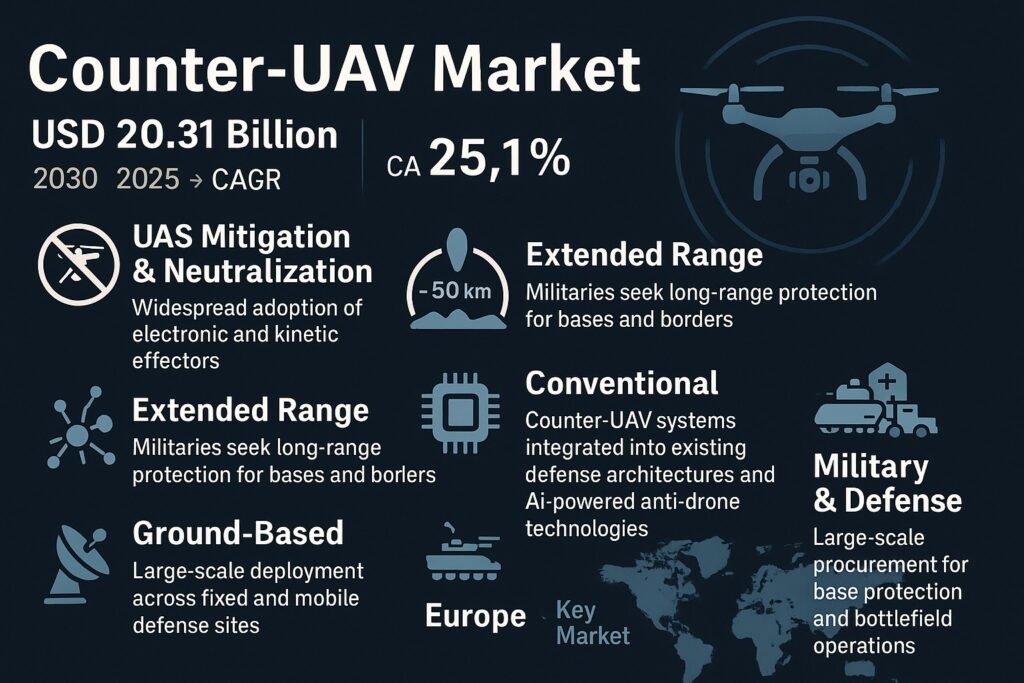The Counter UAV Market is witnessing unprecedented growth as governments, defense forces, and commercial sectors recognize the urgent need to mitigate risks posed by unmanned aerial vehicles (UAVs). Estimated at USD 6.64 billion in 2025, the market is projected to reach USD 20.31 billion by 2030, reflecting a CAGR of 25.1%. Rising security concerns, the proliferation of drones in both military and civilian airspace, and advancements in counter-drone technologies are key drivers behind this rapid expansion.

Key Market Drivers
Escalating Drone Threats – The increasing use of UAVs in asymmetric warfare, surveillance, and illicit activities has heightened the demand for robust counter-UAV solutions. Airports, military installations, critical infrastructure, and public events are particularly vulnerable, prompting accelerated adoption of detection and neutralization systems.
Download PDF Brochure @ https://www.marketsandmarkets.com/pdfdownloadNew.asp?id=4197284
Advanced Technological Integration – Modern counter-UAV solutions combine radar, RF sensors, EO/IR cameras, jamming units, and AI-based threat analytics into unified platforms. This integration ensures real-time detection, tracking, and mitigation of UAVs, even in complex or contested environments, making these systems indispensable in the Counter UAV Market.
Defense Modernization Programs – Countries across North America, Europe, and Asia are investing in mobile, transportable, and ground-based counter-UAV systems as part of broader military modernization programs. These deployments enhance battlefield surveillance, secure critical infrastructure, and strengthen command and control operations.
Commercial and Public Safety Adoption – Beyond defense, industries such as aviation, energy, logistics, and urban management are increasingly deploying counter-UAV solutions to prevent drone-related disruptions and ensure public safety, driving market growth.
Market Segmentation
By Solution:
- Drone Detection & Tracking – Core to counter-UAV operations, enabling precise situational awareness.
- Command & Control (C2) Systems – Centralized frameworks for coordinating UAV neutralization strategies.
- UAV Mitigation & Neutralization – Includes RF jammers, high-energy lasers, and microwave systems to disable hostile UAVs effectively.
By Deployment:
- Ground-Based Systems – Expected to dominate, offering fixed, mobile, and transportable configurations to protect military bases, airports, and borders.
- Handheld Systems – Provide portable, tactical counter-UAV capabilities for law enforcement and security personnel.
By Range:
- Extended Range (>50 KM) – Supports long-distance surveillance and interception, crucial for battlefield and border security.
- Short and Medium Range (<50 KM) – Optimized for local security, airports, and commercial facility protection.
By End-User:
- Defense – Largest segment, leveraging counter-UAV technologies for battlefield dominance and asset protection.
- Government & Law Enforcement – Utilize solutions for border security, counter-terrorism, and public event safety.
- Commercial Sector – Includes airports, energy plants, and urban areas adopting counter-UAV systems to prevent operational disruptions.
Regional Insights
North America leads the Counter UAV Market, driven by high defense budgets, homeland security initiatives, and advanced AI-based counter-UAV platforms. Strategic programs by the US Department of Defense and collaborations with leading OEMs are accelerating deployment across military and civilian sectors.
Europe, Asia Pacific, and the Middle East are also witnessing significant growth due to rising cross-border drone threats, defense modernization initiatives, and critical infrastructure protection needs.
Key Players
Prominent companies shaping the Counter UAV Market include:
- Lockheed Martin (US)
- Northrop Grumman (US)
- RTX (US)
- IAI (Israel)
- Thales (France)
- Rheinmetall AG (Germany)
- RAFAEL Advanced Defense Systems (Israel)
- BAE Systems (UK)
- Elbit Systems (Israel)
- Saab AB (Sweden)
These companies offer comprehensive portfolios of detection, tracking, and neutralization solutions, with strong global distribution and support networks, driving widespread market adoption.
Ask for Sample Report @ https://www.marketsandmarkets.com/requestsampleNew.asp?id=4197284
Market Outlook
The Counter UAV Industry is poised for transformative growth over the next decade. Advancements in AI, electronic warfare, and directed-energy technologies will enhance threat detection and mitigation capabilities. Ground-based and extended-range systems will continue to dominate, while portable and tactical counter-UAV solutions will grow steadily for law enforcement and commercial applications.
For defense contractors, technology providers, and system integrators, the Counter UAV Market presents significant opportunities to deliver scalable, resilient, and adaptive solutions that protect against evolving UAV threats in military, governmental, and commercial domains.